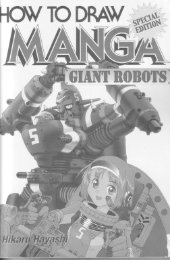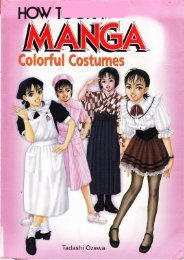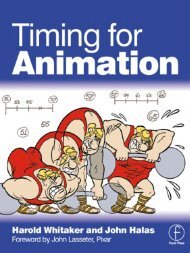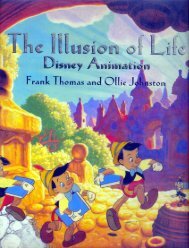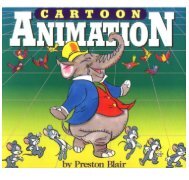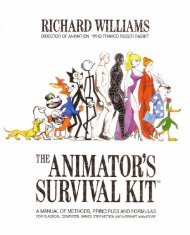- Page 1 and 2: y Eric Goldberg
- Page 4 and 5: HarAceR tliftla iON CRAsh by Eric G
- Page 6: For Susan, the best Art Director a
- Page 10 and 11: Introduction How do you create an a
- Page 12: INTRODUCTION XIII are: And now some
- Page 15 and 16: X VI CHARACT ER ANIMATION CRASH COU
- Page 17 and 18: XVII I CHARACTER ANIMATION CRASH CO
- Page 19 and 20: XX CHARACTER AN I MATION CRASH COUR
- Page 21: XX II CHARACTER ANIMATION CRASH COU
- Page 25 and 26: 4 CHARACTER ANIMATION CRASH COURSE
- Page 27 and 28: 6 CHARACTER ANIMATION CRA SH COURSE
- Page 29 and 30: 8 CHARACTER ANIMATION CRASH COURSE
- Page 31 and 32: 10 CHARACTER ANIMATION CRASH COURSE
- Page 33 and 34: 11 CHARACTER ANIMATION CRASH COURSE
- Page 35 and 36: 14 CHARAC T ER AN I MATION CRASH CO
- Page 37 and 38: Acting in Animation - Part 1: Getti
- Page 39 and 40: 18 CHARACTER ANIMATION CRASH COURSE
- Page 41 and 42: 20 CHARACTER ANIMAT I ON CRASH COUR
- Page 43 and 44: ll CHARACTER ANIMATION CRASH COURSE
- Page 45 and 46: 24 CHARACT ER ANI MATION CRASH COUR
- Page 47 and 48: 26 CHARACTER ANIMATION CRASH COURSE
- Page 49: 28 CHARACTER ANIMATION CRASH COURSE
- Page 53 and 54: 32 CHARACTER ANIMATION CRASH COURSE
- Page 55 and 56: l4 CHARACTER ANIMATION CRASH COURSE
- Page 57 and 58: 36 CHARACTER ANIMATION CRASH COURSE
- Page 59 and 60: 38 CHARACTER ANIMAT I ON CRASH COUR
- Page 61 and 62: 40 CHARACTER ANIMATION CRASH COURSE
- Page 63 and 64: Character Construction and Design M
- Page 65 and 66: 44 CHARACTER ANIMATION CRASH COURSE
- Page 67 and 68: 46 CHARACTER AN I MATION CRASH COUR
- Page 69 and 70: 48 CHARACTER ANIMATION CRASH COURSE
- Page 71 and 72: 50 CHARACTER ANIMATION CRASH COURSE
- Page 73 and 74: 51 CHARACTER ANIMATION CRASH COURSE
- Page 75 and 76: Drawing in Animation Finding the po
- Page 77 and 78: 56 CHARACTER ANIMATION CRASH COURSE
- Page 79 and 80: 58 CHARACTER ANIMATION CRASH COURSE
- Page 81 and 82: 60 CHARACTER ANIMATION CRASH COURSE
- Page 83 and 84: 62 CHARACTER ANIMATION CRASH COURSE
- Page 85 and 86: 64 CHARACTER ANIMATION CRASH COURSE
- Page 88 and 89: The Exposure Sheet Th e traditional
- Page 90 and 91: THE EXPOSURE SHEET 69 It is normall
- Page 92 and 93: THE EXPOSURE SHEET 71 The Dialogue
- Page 94 and 95: THE EXPOSURE SHEET 73 Now here's th
- Page 96 and 97: Layout and Staging Ani mators need
- Page 98 and 99: LAYOUT AND STAG I NG 77 Layout The
- Page 100 and 101:
.. LAYOUT AND STAGING 79 Example 1:
- Page 102 and 103:
LAYOUT AND STAGING 81 Example 2: He
- Page 104 and 105:
LAYOUT AND STAGING 83 ,, I \ I \ I
- Page 106 and 107:
LAYOUT AND STAGING 85 Instead of a
- Page 108 and 109:
LAYO U T AND STAGING 87 5000 1 :85
- Page 110 and 111:
LAY O U T AND STAGING 89 • More e
- Page 112 and 113:
LAYOUT AND STAGING 91 to scene of t
- Page 114 and 115:
LAYOUT AND STAGING 93 • Don't bre
- Page 116 and 117:
LAYOUT AND STAGING 95 Plan your cha
- Page 118 and 119:
LAYO UT AND STAGING 97 • Does the
- Page 120 and 121:
TIMING 99 stronger if you have the
- Page 122 and 123:
TIMING I 01 As well as varying the
- Page 124 and 125:
SPACING 103 • The closer together
- Page 126 and 127:
SPACING 105 You might also encounte
- Page 128 and 129:
SPACING 107 • The gap between the
- Page 130 and 131:
SPACING 109 Spacing in CG Animation
- Page 132 and 133:
HAVING A BREAKDOWN! Ill Example: ~
- Page 134 and 135:
HAVING A BREAKDOWN! Ill Basically,
- Page 136 and 137:
HAVING A BREAKDOWN! 115 Breakdowns
- Page 138 and 139:
Squash and Stretch One of the most
- Page 140 and 141:
SQUASH AND STRETCH 119 ,, B ----00
- Page 142 and 143:
SQUASH AND STRETCH 121 force! Of co
- Page 144 and 145:
OVERLAPP ING ACTION 113 Granted, no
- Page 146 and 147:
OVERLAPPING ACTION 125 • Drag on
- Page 148 and 149:
OVERLAPPING ACTION 127 • 16 Mini-
- Page 150 and 151:
m Weight, Balance, Mass and Volume
- Page 152 and 153:
WEIGHT , BALANCE, MASS AND VOLUME I
- Page 154 and 155:
WEIGHT, BALANCE, MASS AND VOLUME IU
- Page 156 and 157:
WEIGHT. BALANCE , MASS AND VOLUME 1
- Page 158 and 159:
PROPERTIES OF MATTER 137 meet air r
- Page 160 and 161:
PROPERTIES OF MATTER 139 When anima
- Page 162 and 163:
PROPERTIES OF MATTER 141 The same p
- Page 164 and 165:
PROPERTIES OF MATTER 141 Paper woul
- Page 166 and 167:
PROPERTIES OF MATTER 145 Drapery ca
- Page 168 and 169:
FACIAL EXPRESSIONS 147 ~ r 00IJ)l.S
- Page 170 and 171:
FACIAL EXPRESSIONS 149 Utilize elem
- Page 172 and 173:
Lip-Sync Lip-sync is a particularly
- Page 174 and 175:
LIP-SYNC 153 • The 40's Guys In t
- Page 176 and 177:
LIP-SYNC 155 Often one pose with an
- Page 178 and 179:
LIP-SYNC 157 • The Nitty-Gritty
- Page 180 and 181:
LIP-SYNC 159 ''DR- - 0 - ------ p!
- Page 182 and 183:
LIP -SYN C 161 • Learn ways to hi
- Page 184 and 185:
LIP - SYNC 163 • Don't be afraid
- Page 186 and 187:
IDI Animating Shapes Successful and
- Page 188 and 189:
ANIMATING SHAPES 167 © Disney Ente
- Page 190 and 191:
ANIMATING SHAPES 169 The most disto
- Page 192 and 193:
Flexible Drawing for Graphic Charac
- Page 194 and 195:
FLEXIBLE DRAWING FOR GRAPHIC CHARAC
- Page 196 and 197:
FLEXIBLE DRAWING FOR GRAPHIC CHARAC
- Page 198 and 199:
In this example X-sheet, the keys a
- Page 200 and 201:
ANIMATING TO MUSIC 179 Magic Carpet
- Page 202 and 203:
ANIMATING TO MUSIC 181 Kent showed
- Page 204 and 205:
GIMMICKS! 183 ''Blur" or ''swish''
- Page 206 and 207:
GIMMICKS! 185 ~~wiggle" lines when
- Page 208 and 209:
GIMMICKS! 187 Step 2: Go back and p
- Page 210 and 211:
GIMMICKS! 189 Dust clouds after a z
- Page 212 and 213:
GIMMICKS! 191 Method =#=2 : Draw a
- Page 214 and 215:
GIMMICKS! 193 All of these methods
- Page 216 and 217:
GIMMICKS! 195 ~·· 12f hold 1 f 1f
- Page 218 and 219:
GIMMICKS! 197 There's a great scene
- Page 220 and 221:
GIMMICKS! 199 Throwing a punch: Art
- Page 222 and 223:
GIMMICKS! 201 Camera shakes: If you
- Page 224:
Purr;Ng lT Jill TogeTheR
- Page 227 and 228:
206 CHARACTER ANIMATION CRASH COURS
- Page 229 and 230:
108 CHARACTER ANIMATION CRASH COURS
- Page 231 and 232:
2 10 CH A RACTER ANIMATION CR ASH C
- Page 233 and 234:
212 CHARACTER ANIMATION CRASH COURS
- Page 235 and 236:
Is That All, Folks? That's intended
- Page 237 and 238:
About the Author Eric Goldberg is a
- Page 239:
liB CHARACTER AN I MATION CRASH COU







